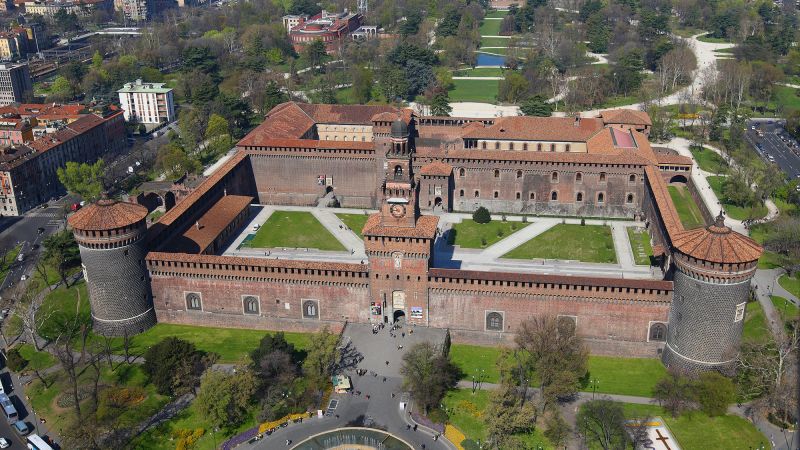Leonardo da Vinci, renowned for his contributions to art and science, also played a significant role in military architecture during the Renaissance. His innovations in warfare strategy and design helped shape the battle practices of the time. Most notably, da Vinci’s sketches and manuscripts have demonstrated a foresight and intuition that defied the norms of his era. Recently, researchers have uncovered exciting new evidence of his contributions to the defensive systems in Milan, specifically concerning the Sforza Castle. A hidden network of underground passageways believed to be linked to da Vinci’s designs has come to light, providing a tangible connection to Vinci’s extraordinary mind.
The remarkable discovery was announced by the Politecnico di Milano in January 2023. Utilizing cutting-edge nondestructive techniques such as ground-penetrating radar and laser scanning, scientists were able to survey and digitally map the subterranean structures of the 15th-century Sforza Castle. This innovative undertaking brought to the forefront a historical narrative that had been largely speculative until now. Archaeologist Francesca Biolo led this initiative as part of her doctoral thesis, and her commitment to uncovering the layers of history beneath the castle exemplifies the enduring legacy of da Vinci’s architectural prowess.
Biolo shared her insights on the significance of the research, asserting that understanding urban history deepens our appreciation for cultural heritage. This approach toward preservation and acknowledgment of historical elements is crucial in understanding the complexities of our cities. While it remains unclear how deeply da Vinci influenced the actual construction of Sforza Castle, the discovery reinforces his impact on its architectural evolution. This finding echoes across multiple dimensions of historical significance, revealing uncharted territories that warrant further exploration.
Initially, the research team focused on the area beneath the Ghirlanda, a protective wall encircling the castle. To their astonishment, they uncovered a previously unrecognized tunnel that runs parallel to a known passage, about three feet underground. This newly discovered tunnel is believed to have served as a strategic route for soldiers, aiding in the defense of the Ghirlanda against enemy incursions. The project unearthed numerous tunnels, predominantly constructed of brick, with barrel vaulted ceilings leading in several directions, potentially creating a complex network of both functional and symbolic passages.
Among these tunnels is one speculated to connect to the Basilica of Santa Maria delle Grazie, the burial site of Ludovico Sforza’s wife. Historical references suggest that Ludovico, often referred to as Ludovico il Moro, commissioned the tunnel during a period marked by personal tragedy. Biolo and her team suggest that further surveys could definitively ascertain whether this tunnel leads to the basilica, potentially unlocking more narratives from Milan’s past. This exploration into subterranean spaces reveals that the castle’s original dimensions far exceed the remnants visible today.
Biolo’s findings not only illuminate the architectural complexities but also poignantly highlight the necessity for ongoing exploration and preservation. The castle’s history is interwoven with various epochs, encountering significant alterations during the Napoleonic wars and in the subsequent restorations of the late 19th century. These excavations serve as a testament to the resilience of historical narratives and underscore how crucial it is to confront and honor our past.
Da Vinci had a notable presence at the Sforza Castle in the late 1400s, serving Duke Ludovico Sforza’s court. His role at the castle included painting the Sala delle Asse and producing a series of defensive architectural sketches. Dr. Francesca Fiorani, a leading scholar on Leonardo at the University of Virginia, emphasizes the importance of reconstructing the past through collaborative endeavors, where da Vinci’s innovative designs provide a glimpse into the architectural ideation of the Renaissance.
While Biolo stresses that determining the precise connection between da Vinci’s drawn designs and the actual structures will require further investigation, this discovery encourages a broader understanding of architectural history. It establishes a narrative that history is often layered and complex, waiting to be unveiled through meticulous research and modern technology.
As a continuing focus on the preservation of Italy’s municipal buildings develops, Biolo has underscored the need for conscious efforts toward protecting and honoring our historical heritage. The freshly uncovered tunnels and passageways at Sforza Castle and the potential stories they hold demonstrate the necessity of marrying our understanding of history with contemporary practices to ensure the past is remembered and preserved for future generations.












